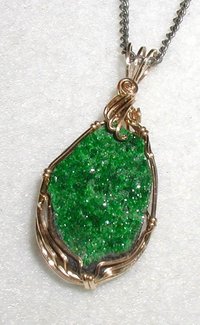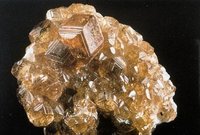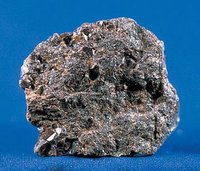Garnet
|
|
The Garnet group of minerals show crystals with a habit of rhombic dodecahedrons and trapezohedrons. They are nesosilicates with the same general formula, A3B2(SiO4)3. The chemical elements in garnet include calcium, magnesium, aluminium, iron2+, iron3+, chromium, manganese, and titanium. Garnets show no cleavage and a dodecahedral parting. Fracture is conchoidal to uneven; some varieties are very tough and are valuable for abrasive purposes. Hardness is 6.5 - 7.5, specific gravity is 3.1 - 4.3, luster is vitreous to resinous, and they can be transparent to opaque.
The name "garnet" comes from the Latin granatus, a grain possibly in reference to malum garanatum (pomegranate) a plant with red seeds similar in shape, size and color to some garnet crystals.
There is a misconception that garnets are a red gem but in fact they come in a wide variety of colors including purple, red, orange, yellow, green, brown, black, or colorless. The lack of a blue garnet was remedied in 1998 following the discovery of color-change blue to red/pink material in Bekily, Madagascar, These stones are very rare. Color-change garnets are by far the rarest garnets except uvarovite, which does not come in cuttable sizes. In daylight, their color can be shades of green, beige, brown, gray and rarely blue, to a reddish or purplish/pink color in incandescent light. By composition, these garnets are a mix of spessartine and pyrope, as are Malaya garnets. The color change of these new garnets is often more intense and more dramatic than the color change of top quality Alexandrite which is frequently disappointing, but still sells for many thousands of dollars (US) per carat. It is expected that blue color-change garnets will match Alexandrite prices or even exceed them as the color change is often better and these garnets are much rarer. The blue color-change type is mainly caused by relatively high amounts of vanadium (about 1 wt.% V2O3).
Six common varieties of garnet are recognized based on their chemical composition. They are pyrope, almandine or carbuncle, spessartite, grossularite (varieties of which are hessonite or cinnamon-stone and tsavorite), uvarovite and andradite. The garnets make up two solid solution series; 1. pyrope-almandine-spessarite and 2. uvarovite-grossularite-andradite.
Garnet is the birthstone for January, and has been used since the Bronze Age.
Missing image Blue-garnet.jpg A color change Blue garnet |
| Contents |
Garnet Group Members
Grossularite
Grossularite is a calcium-aluminium garnet with the formula Ca3Al2(SiO4)3, though the calcium may in part be replaced by ferrous iron and the aluminium by ferric iron. The name grossularite is derived from the botanical name for the gooseberry, grossularia, in reference to the green garnet of this composition that is found in Siberia. Other shades include cinnamon brown (cinnamon stone variety), red, and yellow. Because of its inferior hardness to zircon, which the yellow crystals resemble, they have also been called hessonite from the Greek meaning inferior. Grossularite is found in contact metamorphosed limestones with vesuvianite, diopside, wollastonite and wernerite.
One of the most sought after varieties of gem garnet is the fine green grossular garnet from Kenya and Tanzania called tsavorite. This garnet was discovered in the 1960s in the Tsavo area of Kenya, from which the gem takes its name.
Pyrope
Pyrope, from the Latin pyropos, means similar to fire. It is ruby-red in color and chemically a magnesium aluminium silicate with the formula Mg3Al2(SiO4)3, though the magnesium can be replaced in part by calcium and ferrous iron. The color of pyrope varies from deep red to almost black. Transparent pyropes are used as gemstones.
A variety of pyrope from Macon County, North Carolina is a violet-red shade and has been called rhodolite, from the Greek meaning "a rose." In chemical composition it may be considered as essentially an isomorphous mixture of pyrope and almandite, in the proportion of two parts pyrope to one part almandite. Pyrope has nicknames of Cape ruby, Arizona ruby, California ruby, Rocky Mountain ruby, and Bohemian garnetfrom the Czech Republic. Another intriguing find is the blue color-change garnets from Madagascar, a pyrope spessatine mix. The color of these blue garnets is not like sapphire blue in subdued daylight but more reminiscent of the grayish blues and greenish blues sometimes seen in spinel However in white LED light the color is equal to the best corn flower blue sapphire or D block tanzanite this is due to the blue garnets ability to absorb the yellow component of the emitted light.
Pyrope is an indicator mineral for high pressure rocks. The garnets from mantle derived rocks, peridotites and eclogites, commonly contain a pyrope variety.
Almandite
Almandite, sometimes called almandine, is the modern gem known as carbuncle (though originally almost any red gemstone was known by this name). The term "carbuncle" is derived from the Latin meaning "little spark." The name Almandite is a corruption of Alabanda, a region in Asia Minor where these stones were cut in ancient times. Chemically, almandite is an iron-aluminium garnet with the formula Fe3Al2(SiO4)3; the deep red transparent stones are often called precious garnet and are used as gemstones (being the most common of the gem garnets). Almandite occurs in metamorphic rocks like mica schists, associated with minerals such as staurolite, kyanite, andalusite, and others. Almandite has nicknames of Oriental garnet, almandine ruby, and carbuncle.
Spessartite
Spessartite or spessartine is manganese aluminium garnet, Mn3Al2(SiO4)3. It's name is derived from Spessart in Bavaria. It occurs most often in granite pegmatite and allied rock types and in certain low grade metamorphic phyllites. Spessartite of a beautiful orange-yellow is found in Madagascar. Violet-red spessartites are found in rhyolites in Colorado and Maine.
Uvarovite
Uvarovite is a calcium chromium garnet with the formula Ca3Cr2(SiO4)3. It is a rather rare garnet, bright green in color, usually found as small crystals associated with chromite in peridotite, serpentinite, and kimberlites. It is sometimes found in crystalline marbles and schists. It is found in the Ural mountains of Russia and Outukompu, Finland.
Knorringite
Knorringite is a magnesium chromium garnet with the formula Mg3Cr2(SiO4)3. Pure knorringite never occur in nature. Garnet with high knorringite content may be generated only under high pressure. Knorringite is basically pyrope with a very high chromium content and is often found in kimberlites and is used as an indicator mineral in the search for diamonds.
Andradite
Andradite is a calcium-iron garnet, Ca3Fe2(SiO4)3, is of variable composition and may be red, yellow, brown, green or black. The recognized subvarieties are topazolite (yellow or green), demantoid (green) and melantite (black). Andradite is found both in deep-seated igneous rocks like syenite as well as serpentines, schists, and crystalline limestone. Demantoid has been called the "emerald of the Urals" from its occurrence there, and is one of the most prized of garnet varieties. Topazolite is a golden yellow variety and melanite is a black variety.
Synthetic Garnets
In yttrium iron garnet (YIG), Y3Fe2(FeO4)3, the five iron(III) ions occupy two octahedral and three tetrahedral sites, with the yttrium(III) ions coordinated dodecahedrally by eight oxygen ions. The iron ions in the two coordination sites exhibit different spins, resulting in magnetic behaviour. By substituting specific sites with rare earth elements, for example, interesting magnetic properties can be obtained. One example for this is gadolinium gallium garnet, Gd3Ga2(GaO4)3, which is synthesized for use in magnetic bubble memory. Yttrium aluminium garnet (YAG), Y3Al2(AlO4)3, is used for synthetic gemstone. When doped with neodymium (Nd3+), these YAl-Garnets are useful as the lasing medium in lasers.
Uses of garnets
Pure crystals of garnet are used as gemstones. Garnet sand is a good abrasive. Pyrope varieties are used as kimberlite indicator minerals in diamond prospecting.
Garnets are very abundant in the lower crust and mantle and thus play an important role in geochemical understanding of the Earth.
References
- Dana's Manual of Mineralogy ISBN 0471032883
- Color Encyclopedia of Gemstones ISBN 0442203330
- Mindat.org (http://www.mindat.org/min-1651.html)
- Minerals.net (http://www.minerals.net/mineral/silicate/neso/garnet/garnet.htm)
- Mineral galleries (http://mineral.galleries.com/minerals/silicate/garnets.htm)
- USGS Garnet locations - USA (http://minerals.usgs.gov/minerals/pubs/commodity/gemstones/sp14-95/garnet.html)bg:Гранат
de:Granat fr:Grenat ja:柘榴石 pl:Granat (minerał) pt:Granada (mineralogia)



